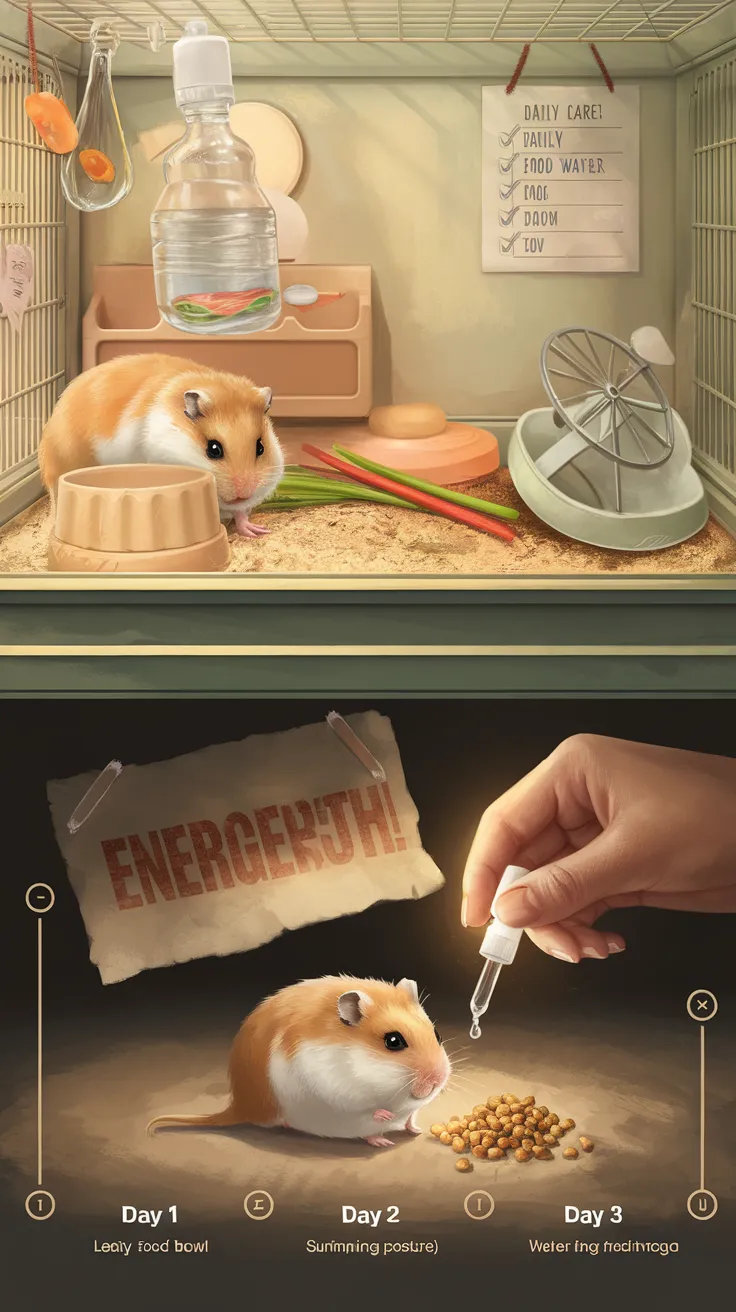Hamster Care Tips: Essential Advice for Happy and Healthy Pets
Hamsters are charming and fun pets. They require proper care to stay healthy.
Hamster care can seem overwhelming at first. But with the right tips, it becomes easy and enjoyable. Proper care ensures your hamster lives a happy and long life. Hamsters are small but full of energy. They need a clean, safe environment.
Their diet should be balanced and nutritious. Regular exercise is also crucial. Understanding their behavior helps in providing better care. This blog will guide you through essential hamster care tips. From setting up their habitat to feeding and health checks, we cover it all. Let’s ensure your furry friend thrives in your care. Keep reading to learn more about making your hamster’s life comfortable and joyful.
Choosing The Right Habitat
Choosing the right habitat for your hamster is essential. A comfortable and safe environment helps them thrive. This section will guide you through selecting the perfect habitat for your furry friend.
Cage Size
The size of the cage is crucial for your hamster’s well-being. A spacious cage allows for exercise and exploration.
- Minimum size: 360 square inches of floor space
- Bigger is always better for hamster health
Ensure the cage has enough room for toys, a wheel, and hiding spots.
Bedding Options
Choosing the right bedding is important for hygiene and comfort. Here are some popular options:
| Bedding Type | Pros | Cons |
|---|---|---|
| Aspen Shavings | Natural, safe, affordable | Can be dusty |
| Paper-Based | Soft, absorbent, dust-free | More expensive |
| Timothy Hay | Natural, promotes digging | Not very absorbent |
Avoid cedar and pine shavings. They can be harmful to hamsters.
Feeding Your Hamster
Feeding your hamster properly is essential for their health and happiness. Providing a balanced diet ensures they get the nutrients they need. Let’s dive into the specifics of a nutritious diet and the best treats for your hamster.
Nutritious Diet
A hamster’s primary diet should consist of high-quality hamster pellets or lab blocks. These contain the right balance of nutrients.
- Pellets: Choose pellets made specifically for hamsters. They offer balanced nutrition in every bite.
- Seeds: Provide a mix of seeds, but avoid fatty ones like sunflower seeds in large amounts.
Include fresh vegetables in their diet for added vitamins and minerals. Suitable vegetables include:
- Carrots
- Broccoli
- Cucumbers
- Kale
Fresh fruits are also good but should be given sparingly. Examples are:
- Apples (without seeds)
- Bananas
- Blueberries
Always ensure fresh water is available. Use a water bottle with a sipper tube to keep the water clean.
Treats And Snacks
While treats are fun, they should be given in moderation. Too many treats can lead to obesity.
Healthy treat options include:
- Small pieces of cooked chicken
- Boiled eggs
- Plain popcorn (no butter or salt)
Avoid sugary or salty snacks. They can harm your hamster’s health. Also, refrain from giving them chocolate, caffeine, or junk food. These can be toxic.
Offer treats as a reward during playtime or training sessions. This helps reinforce positive behavior.
Hydration Essentials
Caring for a hamster involves many responsibilities. One of the most important is ensuring proper hydration. Water is vital for your hamster’s health and well-being. Below, we will explore some essential tips for keeping your hamster hydrated.
Water Bottles
Choose a water bottle designed for small pets. These bottles have a nozzle that allows your hamster to drink easily. Ensure the bottle is securely attached to the cage. Refill the bottle daily to keep the water fresh. Check the nozzle regularly to ensure it is not clogged.
Water Quality
Always provide clean, fresh water for your hamster. Use filtered or bottled water to avoid contaminants. Tap water may contain harmful chemicals. Change the water daily to prevent bacteria growth. Clean the water bottle weekly to maintain hygiene.
Exercise Needs
Hamsters are active creatures. They need regular exercise to stay healthy. Without exercise, they can become overweight. They may also develop health issues. Meeting their exercise needs is crucial. It keeps them happy and fit.
Running Wheels
Running wheels are essential for hamsters. They love to run and explore. A wheel provides endless fun. Ensure the wheel is the right size. It should be at least 8 inches in diameter. Small wheels can hurt their backs. Solid wheels are best. Avoid wire wheels. They can injure tiny feet.
Place the wheel in the cage. It should spin smoothly. Check it regularly for damage. A broken wheel can be dangerous. Keep the wheel clean. Hamsters may use it as a bathroom. Clean it weekly with mild soap and water.
Playtime Activities
Playtime outside the cage is important too. It gives hamsters a change of scenery. Supervised playtime prevents boredom. Create a safe play area. Use a playpen or a hamster ball. Ensure the area is escape-proof.
Provide toys for enrichment. Tunnels, chew toys, and climbing structures are great options. Rotate toys to keep things interesting. Avoid toys with small parts. They can be choking hazards. Always supervise playtime. Hamsters are curious. They can get into trouble quickly.
Handling And Socialization
Socializing and handling your hamster is key to their happiness. It also helps build a strong bond between you and your pet. Proper handling ensures they feel safe and secure. Here are some effective tips for handling and socializing your hamster.
Gentle Handling
Always approach your hamster with gentle movements. Sudden actions can scare them. Use both hands to scoop them up slowly. Support their entire body to make them feel secure.
- Move slowly and speak softly.
- Let your hamster sniff your hand first.
- Use a small cup or tunnel to lift them if they seem nervous.
Frequent, gentle handling helps your hamster get used to human contact. This reduces stress and makes them more friendly over time.
Building Trust
Building trust with your hamster takes patience and time. Start by spending time near their cage. Let them get used to your presence.
- Offer treats from your hand to build positive associations.
- Talk to them softly while they eat.
- Gradually increase the time you spend handling them each day.
Over time, your hamster will learn that you are a source of comfort and safety. This trust forms the foundation of a strong, loving bond.
Health Monitoring
Hamsters are small and delicate pets. Regular health checks are crucial. Monitoring their health helps detect issues early. This ensures a happier and healthier hamster.
Common Illnesses
Hamsters can suffer from various illnesses. Wet tail is a common disease. It causes diarrhea and requires immediate attention. Respiratory infections are another concern. Symptoms include sneezing and breathing difficulties. Skin issues like mites can cause itching. Eye problems and dental issues are also common.
Veterinary Care
Regular vet visits are essential. A vet can spot health problems early. They provide necessary treatments. Always choose a vet experienced with small animals. Keep their contact information handy. This helps in emergencies.
Ensure your hamster’s vaccinations are up to date. Ask the vet about dietary needs. They can guide you on proper nutrition. Following their advice ensures your hamster stays healthy.
Grooming Tips
Hamsters are self-groomers, but they still need some help from you. Proper grooming keeps them healthy and happy. It prevents hair and nail issues. Let’s explore some effective grooming tips.
Coat Care
Regular brushing is crucial for your hamster’s coat. It helps remove loose fur and prevents tangles. Use a soft brush designed for small animals. Brush gently to avoid hurting your pet. Long-haired hamsters need more frequent brushing.
Check your hamster’s fur for signs of parasites or skin problems. Look for bald spots, redness, or excessive scratching. If you notice any issues, consult a vet promptly.
| Coat Type | Brush Frequency |
|---|---|
| Short-haired | Once a week |
| Long-haired | 2-3 times a week |
Nail Trimming
Hamsters’ nails grow continuously. Overgrown nails can cause discomfort and health issues. Check your hamster’s nails regularly. Trim them when they get too long. Use a small animal nail clipper. Be careful to avoid the quick, the pink part of the nail.
Follow these steps for safe nail trimming:
- Gently hold your hamster to keep it still.
- Identify the quick in each nail.
- Trim a little bit at a time.
- Stop if you see any bleeding.
- Reward your hamster with a treat after trimming.
If you are not comfortable trimming nails, ask a vet for help. Regular nail checks prevent health problems and keep your hamster happy.
Creating A Safe Environment
Creating a safe environment for your hamster is crucial. A secure and hazard-free space ensures your pet thrives. This guide will help you set up a safe home for your furry friend.
Escape Prevention
Hamsters are small and curious creatures. They can squeeze through tiny gaps. Ensure the cage bars are close together. Opt for a cage with a secure latch. Regularly check for any damages. Repair or replace any weak points to prevent escapes.
Hazardous Items
Remove any dangerous items from the cage. Avoid using sharp-edged toys. Keep plastic items to a minimum. Hamsters can chew through them. Use wooden or chew-safe materials instead. Avoid toxic plants and chemicals. They can harm your hamster. Provide safe bedding materials. Avoid pine and cedar shavings. They can cause respiratory issues.
Understanding Hamster Behavior
Understanding hamster behavior is key to ensuring a happy and healthy pet. Hamsters have unique ways of communicating their needs and emotions. By observing and interpreting their actions, you can provide better care and improve your bond with your furry friend.
Nocturnal Habits
Hamsters are nocturnal animals. They sleep during the day and are active at night. This means they might be noisy when you are sleeping. Provide a quiet and dark environment for them to rest during the day. Avoid disturbing them while they are asleep.
Body Language
Hamsters communicate a lot through body language. A relaxed hamster will have a smooth, even coat and bright eyes. If they are scared or stressed, they might flatten their body and tuck in their limbs. Watch for signs of discomfort or aggression, such as baring teeth or making loud squeaking sounds.
Understanding these signals will help you respond appropriately. This can make your hamster feel safe and secure. Regular interaction and gentle handling can build trust and reduce stress.
Frequently Asked Questions
How Often Should You Clean A Hamster’s Cage?
Clean a hamster’s cage at least once a week. Spot clean daily to remove waste and soiled bedding.
What Do Hamsters Eat?
Hamsters eat a variety of foods. Their diet includes pellets, fresh vegetables, fruits, and occasional treats.
How Much Exercise Does A Hamster Need?
Hamsters need daily exercise. Provide a wheel, tunnels, and toys to keep them active and healthy.
What Bedding Is Best For Hamsters?
Use unscented paper-based bedding or aspen shavings for hamsters. Avoid pine and cedar, which are harmful.
Conclusion
Caring for your hamster is simple with the right knowledge. Provide fresh food and water daily. Ensure a clean and spacious cage. Regularly interact to keep them happy. Monitor their health closely. Lastly, remember that hamsters are delicate creatures. Treat them with love and patience.
Your little friend will thrive with proper care. Follow these tips for a happy and healthy hamster.



